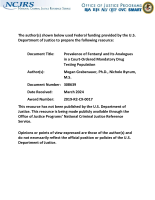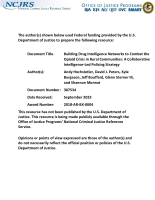Opioid epidemic
The Daunting Task of Strengthening Medical Examiner and Coroner Investigations Across Hundreds of Jurisdictions
After a five-year fact-finding mission, a multi-agency working group has identified a host of problems in the U.S. medical examiner/coroner system, but solutions remain elusive.
Offering Recovery Rather Than Punishment: Implementation of a Law Enforcement-led Pre-arrest Diversion-to-treatment Program for Adults with Substance Use Disorders
Prevalence of Fentanyl and Its Analogues in a Court-Ordered Mandatory Drug Testing Population
The Experiences of Men with Substance Use Disorders Exiting Prison at the Height of the Opioid Crisis
Validation of two methods for the quantitative analysis of cocaine and opioids in biological matrices using LCMSMS
The Need to Rethink Harm Reduction for People Using Drugs Alone to Reduce Overdose Fatalities
Coinciding crises: The effects of the police legitimacy and opioid crises on the culture of a specialized drug investigation unit
Prescription Opioid Resiliency and Vulnerability: A Mixed-Methods Comparative Case Study
A Data-Informed Response to Emerging Drugs
The emerging drug crisis in the U.S. touches both criminal justice and public health, and experts from both fields came together at NIJ’s 2023 National Research Conference to discuss strategies and tools to fight this problem. Dr. Frances Scott, NIJ scientist and program manager, continues the conference discussion with two fellow panelists: Ciena Bayard, the Method Development and Validation Program Manager for D.C. Office of the Chief Medical Examiner, and Haley Greene, the Deputy Epidemiologist for the Central Region for the Virginia Department of Health. Read the transcript.
Decoding hidden darknet networks: What we learned about the illicit fentanyl trade on AlphaBay
Disentangled Dynamic Heterogeneous Graph Learning for Opioid Overdose Prediction
Meeting National Safety Council Recommendations: Accurate Rapid Tests and Laboratory Confirmation Procedures for Fentanyl and Prevalent Opioids in Oral Fluid
Developing a Portable and Fast Opioid Assessment Tool for Improved Field Decision-Making
Building Drug Intelligence Networks to Combat the Opioid Crisis in Rural Communities: A Collaborative Intelligence-Led Policing Strategy
Detection, chemical analysis, and pharmacological characterization of dipyanone and other new synthetic opioids related to prescription drugs
Meeting People Where They Are to Improve Institutional Culture
Incarcerated individuals deserve opportunities for healing and growth, but they often lack the necessary resources for such opportunities. Additionally, organizational cultures that don’t support these outcomes often stand in the way. Researchers and practitioners gathered at NIJ’s 2023 National Research Conference to share ideas and projects that will increase opportunities for incarcerated populations around the country. This show continues their conversation.







